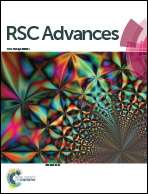A promising insensitive energetic material based on a fluorodinitromethyl explosophore group and 1,2,3,4-tetrahydro-1,3,5-triazine: synthesis, crystal structure and performance†
Abstract
The introduction of fluorodinitromethyl energetic groups is an efficient strategy to improve the performances of energetic materials. In this paper, an insensitive energetic compound 6-(fluorodinitromethyl)-3-nitro-1,2,3,4-tetrahydro-1,3,5-triazine (FMTNT) was designed and synthesized based on the modification of 1,3,5-triazine backbone via the nitration-rearrangement, reduction and fluorination sequence. The single crystal of FMTNT was firstly obtained and determined, meanwhile, this novel structure was also fully characterized by the methods of IR, 1H NMR, 13C NMR, 19F NMR and elemental analysis. Studies on thermal behaviors and detonation performances of FMTNT were also carried out through differential scanning calorimetry (DSC-TG) approach and EXPLO5 program, respectively. The decomposition temperature of FMTNT is found to be at 157.5 °C via thermal chemical analysis and the detonation performances were proved to be good, with a detonation velocity of 8624.8 m s−1 and detonation pressure of 29.1 Gpa. Furthermore, the experimental results showed that impact and friction sensitivity reaches 20 J and 240 N, even less sensitive than TNT, indicating a broad perspective in the application of insensitive explosives and propellants.



 Please wait while we load your content...
Please wait while we load your content...